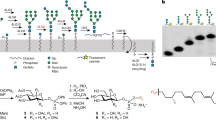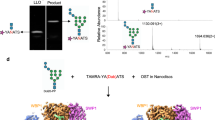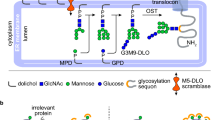Abstract
The endoplasmic reticulum (ER) contains a stringent quality control system that ensures the correct folding of newly synthesized proteins to be exported via the secretory pathway. In this system UDP-Glc:glycoprotein glucosyltransferase (GT) serves as a glycoprotein specific folding sensor by specifically glucosylating N-linked glycans in misfolded glycoproteins thus retaining them in the calnexin/calreticulin chaperone cycle. To investigate how GT senses the folding status of glycoproteins, we generated RNase B heterodimers consisting of a folded and a misfolded domain. Only glycans linked to the misfolded domain were found to be glucosylated, indicating that the enzyme recognizes folding defects at the level of individual domains and only reglucosylates glycans directly attached to a misfolded domain. The result was confirmed with complexes of soybean agglutinin and misfolded thyroglobulin.
This is a preview of subscription content, access via your institution
Access options
Subscribe to this journal
Receive 12 print issues and online access
$189.00 per year
only $15.75 per issue
Buy this article
- Purchase on Springer Link
- Instant access to full article PDF
Prices may be subject to local taxes which are calculated during checkout




Similar content being viewed by others
References
Hurtley, S.M. & Helenius, A. Annu. Rev. Cell Biol. 5, 277–307 (1989).
Ellgaard, L., Molinari, M. & Helenius, A. Science 286, 1882– 1888 (1999).
Trombetta, S.E. & Parodi, A.J. J. Biol. Chem. 267, 9236–9240 ( 1992).
Parker, C.G., Fessler, L.I., Nelson, R.E. & Fessler, J.H. EMBO J. 14, 1294–1303 ( 1995).
Zapun, A. et al. Cell 88, 29–38 (1997).
Helenius, A., Trombetta, E.S., Hebert, D.N. & Simons, J.F. Trends Cell Biol. 7, 193–200 (1997).
Hammond, C., Braakman, I. & Helenius, A. Proc. Natl. Acad. Sci. USA 91, 913–917 (1994).
Gardner, T.G. & Kearse, K.P. J. Biol. Chem. 274, 14094–14099 (1999).
Cannon, K.S.l. & Helenius, A. J. Biol. Chem. 274, 7537–7544 (1998).
Sousa, M.C., Ferrero-Garcia, M.A. & Parodi, A.J. Biochemitry 31, 97– 105 (1992).
Hebert, D.N., Zhang, J.-X., Chen, W., Foellmer, B. & Helenius, A. J. Cell Biol. 139, 613– 623 (1997).
Parodi, A.J. Biochim. Biophys. Acta. 1426, 287– 295 (1999).
Sousa, M. & Parodi, A.J. EMBO J 14, 4196–4203 (1995).
Richards, F.M. & Vithayathil, P.J. J. Biol. Chem. 234, 1459–1465 ( 1959).
Trombetta, S.E. & Helenius, A. J. Cell Biol. in the press (2000).
Kosower, N.S. & Kosower, E.M. Meth. Enzymol. 143 , 264–270 (1987).
Ruoppolo, M. et al. Fold Des. 1, 381–390 (1996).
Trombetta, S., Bosch, M. & Parodi, A.J. Biochemistry 28, 8108– 8116 (1989).
Rudd, P.M. & Dwek, R.A. Crit. Rev. Biochem. Mol. Biol. 32, 1–100 (1997).
Ashford, D.A., Dwek, R.A., Rademacher, T.W., Lis, H. & Sharon, N. Carbohydr. Res. 213, 215–227 (1991).
Rawitch, A.B., Pollock, H.G. & Yang, S.X. Arch. Biochem. Biophys. 300, 271–279 (1993).
Wormald, M.R. & Dwek, R.A. Structure Fold Des. 7 , R155–160 (1999).
Amara, J.F., Cheng, S.H. & Smith, A.E. Trends Cell Biol. 2, 145– 149 (1992).
Aridor, M. & Balch, W.E. Nat. Med. 5, 745–751 (1999).
Allen, H.J. & Johnson, E.A. Carbohydr. Res. 50 , 121–131 (1976).
Chen, Y.H., Yang, J.T. & Martinez, H.M. Biochemistry 11, 4120– 4131 (1972).
Schagger, H. & von Jagow, G. Anal. Biochem. 166 , 368–379 (1987).
Tsurudome, M. et al. J. Biol. Chem. 267, 20225– 20232 (1992).
Acknowledgements
We thank S. Trombetta for valuable help and for introducing us to the RNase system and L. Ellgaard for providing GT. Funding was provided from the Swiss National Science Foundation. C.R. is a graduate student in the ETHZ biochemistry program.
Author information
Authors and Affiliations
Corresponding author
Rights and permissions
About this article
Cite this article
Ritter, C., Helenius, A. Recognition of local glycoprotein misfolding by the ER folding sensor UDP-glucose:glycoprotein glucosyltransferase. Nat Struct Mol Biol 7, 278–280 (2000). https://doi.org/10.1038/74035
Received:
Accepted:
Issue Date:
DOI: https://doi.org/10.1038/74035
This article is cited by
-
Structural and functional analysis of aquaporin-2 mutants involved in nephrogenic diabetes insipidus
Scientific Reports (2023)
-
In vitro mannose trimming property of human ER α-1,2 mannosidase I
Glycoconjugate Journal (2012)
-
Unglycosylation at Asn-633 made extracellular domain of E-cadherin folded incorrectly and arrested in endoplasmic reticulum, then sequentially degraded by ERAD
Glycoconjugate Journal (2008)
-
Minor folding defects trigger local modification of glycoproteins by the ER folding sensor GT
The EMBO Journal (2005)



